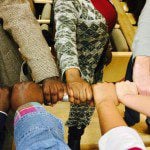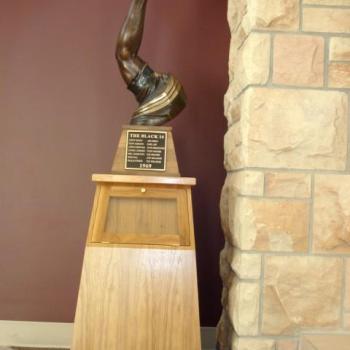This was one of the last posts I did when I blogged at By Common Consent. It has renewed significance now.
My husband and I recently saw a Star Trek: The Next Generation episode called “Darmok.” In it, the Enterprise is threatened with destruction if they can’t interpret the language of the “enemy” ship’s creatures. Captain Picard is sent to a planet to attempt communication with one of these “enemy” aliens. As it turns out, the aliens’ language is all based on metaphors from their folklore. The captain must not only interpret the words but the stories behind them. There is no grammar involved, simply the stories.

We know that soldiers who killed those uniformed as “enemies” and then found evidences of their common humanity–a photo of a wife and children, a letter from a parent–were often haunted by the killing. They would use words like “I murdered”, or “I slaughtered.” When suggestions of personal stories are revealed in letters or photos, epithets like “Kraut” or “Gook” or “Jap” fail. If only for a moment, killed and killer are simply human.
When I was eight years old, my brother and I accompanied my dad to Yucatan. Dad worked with a Baptist minister to learn Maya. They used Bible stories as their texts. The Mayan minister re-told the story of the Prodigal Son using images distinctive to his culture. The prodigal son, for example, had grown his hair long, a sign to Mayans of rebellion. Such details made the story both particular and universal.
Of course, stories can also divide us. I think of some I was told as a young person in Provo, Utah–stories that would keep me separate from Blacks. My seminary teacher informed my class that Blacks were inferior, and that was why God had withheld the priesthood from them. My home teacher read us an alleged prophecy by John Taylor predicting that Blacks would come en masse from California, would invade our temple, ravish our women, and that blood would run down the streets. Like today’s endlessly forwarded emails, this “prophecy” was carried house to house, and finally every bishop was asked to read a letter to his congregation denouncing the prophecy as a fake. We breathed a sigh of relief.
That’s my side of the story, anyway. Darius Gray, my co-author, experienced it from the Black side. He, a good friend of the police chief in Salt Lake City, was shown the plans to prevent the impending attack. He saw where snipers would be put and what other defensive measures were being taken. As for Darius, he arranged to get his wife out of town, and he planned on leaving by horseback, crossing mountain paths rather than public roads. He experienced an entirely different type of fear.
As Darius and I got acquainted, we shared parts of our life stories. He told me about his mother’s death. She had summoned her two children and told them that she was dying. They insisted that the moment hadn’t yet arrived. She repeated, “Children, listen to me. I am dying.” She called her daughter to her and said loving things. It was Darius’s turn next. She called him by his middle name, Aidan. “Aidan,” she said, “come here.” He did. “Aidan, I adore you. I adore you.”
For Darius and me, there was no black and white. We were brother and sister. My children refer to him as “Grandpa D.”
Sometimes the stories we tell involve our view of Christianity. We tend to repeat the notion that we Mormons don’t use crosses on our chapels/temples because we don’t want to remember the crucifixion of Christ but his resurrection. (The empty cross does actually imply his resurrection, but that’s for another post.)
Though I was taught in subtle ways to resist the cross as a symbol of the Savior’s sacrifice, I have been moved to tears by that symbol on another religion’s turf. My family and I visited Lithuania and saw the Hill of Crosses, boldly built in defiance of Soviet rule, which insisted that no crosses be displayed. The Lithuanians sent crosses down the river to be placed on that hill. My father asked me as we approached, “How many crosses do you guess you’ll see?” I said perhaps one thousand. Actually, they weren’t countable. Every cross had several rosaries (with crosses) dangling from the nexus. I could hardly imagine the courage of these people, who had said to the Communist regime: “We are not yours. We are Christ’s.” The story brought me to them and erased our religious distinctions while I surveyed their inspired monument.
Currently, we see the spin on political stories, calculated to make us fear or even hate the “other” side. Some fear feminism or homosexuality or former Mormons. Fear makes us deaf and blind. We will not hear their stories, nor will we see their divinely created faces.
The gospel asks us to open our eyes, ears, minds, hearts. In one story after another, the Savior tells of many prodigals and “unclean” people who open his wells of mercy.
Imagine saying to someone from another planet: “Jesus, when the grave opened.” It would be your call for grace, hope, and it would be your testimony. Their answer? Perhaps some name you’ve never heard, followed by “when the walls fell.”
“For he is our peace, who has made both one, and has broken down the middle wall of partition between us.”
Make it so.












